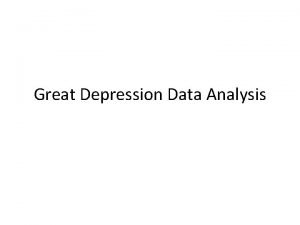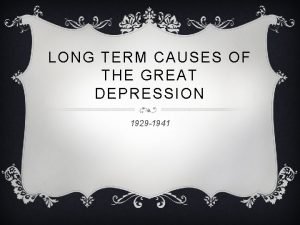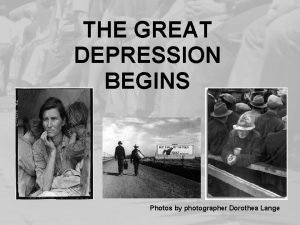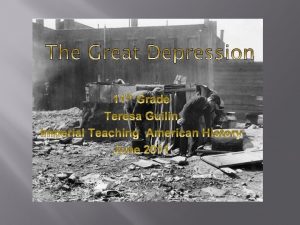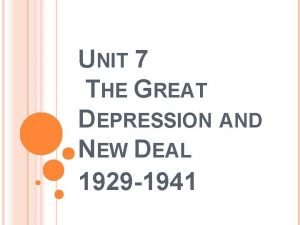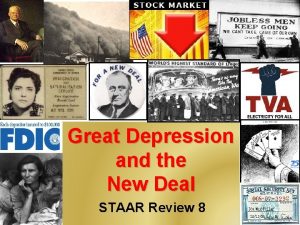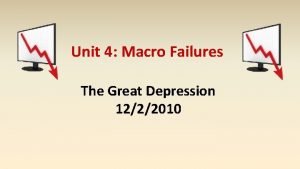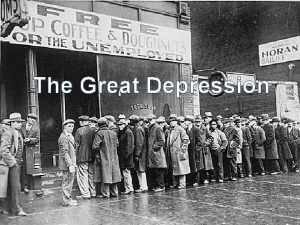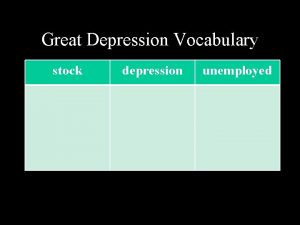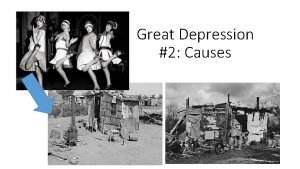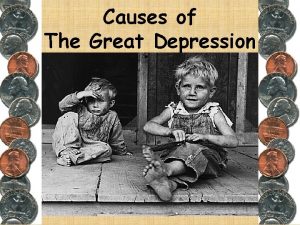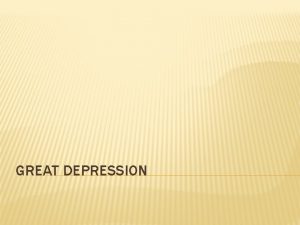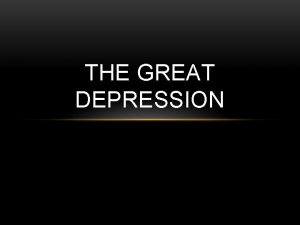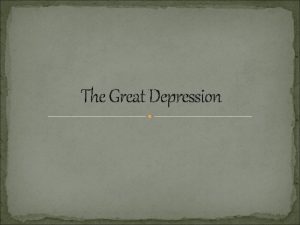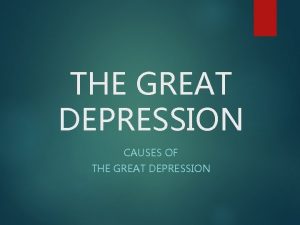Causes of Great Depression What caused the Great












- Slides: 12

Causes of Great Depression

What caused the Great Depression? • Consumer spending had actually begun to decline in 1927 • Layoffs had begun in 1928 and a clear recession had hit by summer of 1929 • Stock market speculation continued despite the slowdown • Stock Market Crash of 1929 • 10% ? of households owned stock • Margin buying • “Black Thursday” (10/24/29) and “Black Tuesday (10/29/29) Economists differ on how much weight to place on market crash

The Stock Market Crash of 1929 – A ten-day period beginning on October 20, 1929, when the value of stocks plummeted as panicked investors sold off their stock in droves. This moment is usually considered the official start of the Depression.

The Bull Market and the Crash • Buyers on margin faced paying hard cash to the cover the loans they received for purchasing stock that sold well below what they had originally paid. • Few people predicted that a depression would follow. • The stock market crash led manufacturers to decrease spending and lay off workers. • Banks, heavily invested in the speculative bubble, began to collapse, intensifying the crisis.

Underlying Weakness of the 1920 s Economy • The crash revealed the underlying economic weakness of the economy • Industrial growth during the 1920 s had not been accompanied by comparable increases in wages or farm income. • The gap between rich and poor widened, as did that between production and consumption.

WHY WAS THIS PANIC MORE SEVERE THAN ANY PREVIOUS ECONOMIC DOWNTURN? • Farmers still made up ¼ of economy – their annual salary was 1/3 other industries • Railroad and coal industries also suffered • Structurally, income distribution was unequal • Hoover used the term “depression” instead of “panic” to calm nerves

A Crisis with Credit • Prosperity of the 20’s had hid flaws in banking structure. Lack of regulation. • • 9, 000 Bank Failures • – Uninsured deposits • – life savings lost • – Impact on middle-class and elderly • – Fell by 88% between 19291932 • • 100, 000 Businesses failures • • GNP declined from $103. 1 billion to $58 billion

Unequal Distribution of Wealth • Top. 1% hold aggregate income equal to the bottom 42% • Bottom 71% annual incomes below $2500 80% have no savings This unequal distribution creates fluctuations in spending • Lag in Consumer Power • Expenditures fell by 18% between 1929 -1932 • Unemployment– 3. 2% in 1929 to 25% by 1933

Depression and Gender • Men’s declining status as breadwinners – Greater impact of depression on “male” industries – Steel industry, mining, and manufacturing

International Depression • Dawes Plan (1924) – Loans to Germany – reduction in amount of reparations owed to Allies – purchase U. S. manufactured goods and agricultural products • European economies collapsed by 1931 – Reduction in demand for U. S. goods – Inability to repay reparations and loans • U. S. reduction of foreign investments • U. S. cutback on purchase of raw materials, supplies, and goods from abroad • Hawley-Smoot Tariff (1930) – Raised tariffs to all-time high

Structural Weaknesses • Farmers – ¼ of employed workers • Low prices • Over production • Default on mortgage payments and risk of foreclosures • • Avg. income $273 compared to $750 • The Dust Bowl (1930 to 1941) – Ecological and humanmade disasters – Drought – Top-soil erosion – 350, 000 relocated West in 1930 s

Who’s to Blame? • Bankers, brokers and businessmen received a lot of the blame • Prof. Henretta- “Hoover had responded to the national emergency with government action on an unprecedented scale” • Ultimately Hoover became the scapegoat
 Great depression causes
Great depression causes What were the long term causes of the great depression
What were the long term causes of the great depression Great depression vocabulary jeopardy
Great depression vocabulary jeopardy Anxiety in the heart of man causes depression
Anxiety in the heart of man causes depression What caused the great schism of 1378
What caused the great schism of 1378 Proximate causation vs ultimate causation
Proximate causation vs ultimate causation Proximate cause ap bio
Proximate cause ap bio Five effects of the great depression
Five effects of the great depression Stock market cartoon
Stock market cartoon Describe the human toll of the great depression
Describe the human toll of the great depression Franklin d. roosevelt
Franklin d. roosevelt Mexican repatriation apush
Mexican repatriation apush Great depression
Great depression
